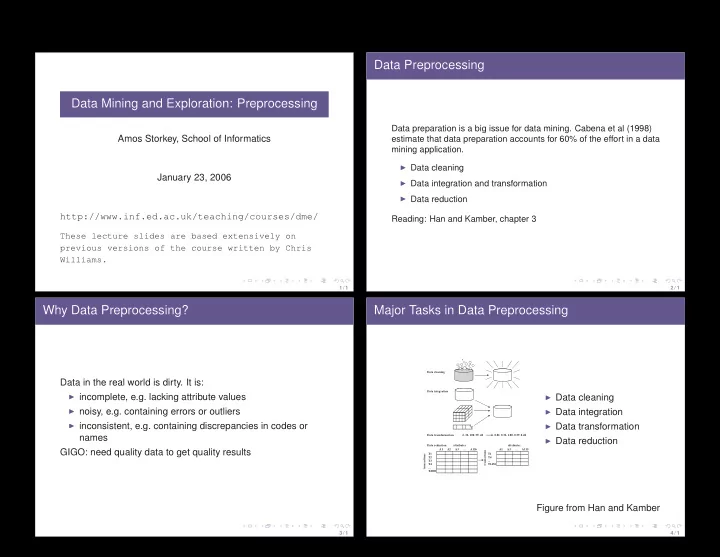

� � Data Preprocessing Data Mining and Exploration: Preprocessing Data preparation is a big issue for data mining. Cabena et al (1998) Amos Storkey, School of Informatics estimate that data preparation accounts for 60% of the effort in a data mining application. ◮ Data cleaning January 23, 2006 ◮ Data integration and transformation ◮ Data reduction http://www.inf.ed.ac.uk/teaching/courses/dme/ Reading: Han and Kamber, chapter 3 These lecture slides are based extensively on previous versions of the course written by Chris Williams. 1 / 1 2 / 1 Why Data Preprocessing? Major Tasks in Data Preprocessing Data cleaning Data in the real world is dirty. It is: Data integration ◮ incomplete, e.g. lacking attribute values ◮ Data cleaning ◮ noisy, e.g. containing errors or outliers ◮ Data integration ◮ inconsistent, e.g. containing discrepancies in codes or ◮ Data transformation names Data transformation 2, 32, 100, 59, 48 0.02, 0.32, 1.00, 0.59, 0.48 ◮ Data reduction Data reduction attributes attributes GIGO: need quality data to get quality results A1 A2 A3 ... A126 A1 A3 ... A115 transactions T1� T1� transactions T2� T4� T3� ...� T4� T1456 ...� T2000 Figure from Han and Kamber 3 / 1 4 / 1
Data Cleaning Tasks Missing Data and Outliers ◮ What happens if input data is missing? Is it missing at random (MAR) or is there a systematic reason for its absence? Let x m denote those values missing, and x p those values that are present. If MAR, some “solutions” are ◮ Handle missing values ◮ Model P ( x m | x p ) and average (correct, but hard) ◮ Identify outliers, smooth out noisy data ◮ Replace data with its mean value (?) ◮ Look for similar (close) input patterns and use them to infer ◮ Correct inconsistent data missing values (crude version of density model) ◮ Reference: Statistical Analysis with Missing Data R. J. A. Little, D. B. Rubin, Wiley (1987) ◮ Outliers detected by clustering, or combined computer and human inspection 5 / 1 6 / 1 Data Integration Data Transformation ◮ Normalization, e.g. to zero mean, unit standard deviation new data = old data − mean Combines data from multiple sources into a coherent store std deviation ◮ Entity identification problem: identify real-world entities or max-min normalization to [ 0 , 1 ] from multiple data sources, e.g. A.cust-id ≡ B.cust-num ◮ Detecting and resolving data value conflicts: for the same new data = old data − min real-world entity, attribute values are different, e.g. max − min measurement in different units ◮ Normalization useful for e.g. k nearest neighbours, or for neural networks ◮ New features constructed, e.g. with PCA or with hand-crafted features 7 / 1 8 / 1
Data Reduction Feature Selection Usually as part of supervised learning ◮ Stepwise strategies ◮ Feature selection: Select a minimum set of features ˜ x from x so that: ◮ (a) Forward selection: Start with no features. Add the one which is the best predictor. Then add a second one to maximize ◮ P ( class | ˜ x ) closely approximates P ( class | x ) performance using first feature and new one; and so on until a ◮ The classification accuracy does not significantly decrease stopping criterion is satisfied ◮ Data Compression (lossy) ◮ (b) Backwards elimination: Start with all features, delete the one ◮ PCA, Canonical variates which reduces performance least, recursively until a stopping criterion is satisfied ◮ Sampling: choose a representative subset of the data ◮ Forward selection is unable to anticipate interactions ◮ Simple random sampling vs stratified sampling ◮ Backward selection can suffer from problems of overfitting ◮ Hierarchical reduction: e.g. country-county-town ◮ They are heuristics to avoid considering all subsets of size k of d features 9 / 1 10 / 1
Recommend
More recommend